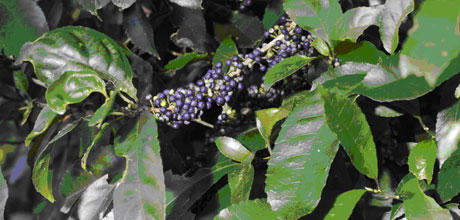Melicytus ramiflorus
This article was first published on 15 Mar 2011.

Melicytus ramiflorus
Small Tree is Abundant
Have you ever picked up leaf skeletons in the bush? Chances are, if you have a near perfect leaf skeleton with an intricate vein pattern, you have a decayed mahoe leaf. This small tree (or large shrub) is common in forest from the coast to lower montane areas throughout the country. These leaves can reach 15cm in length.
While alive the leaves have toothed edges and are borne alternately on slender stalks. The leaves grow up to 3 times as long as they are wide and can reach 15cm in length.
Mahoe begins flowerings in late spring and summer. The small flowers abundantly clad the stems. Male and female flowers are borne on separate trees. The male tree will produce larger yellowish flowers that are beautifully scented, while the female trees have with more diminutive greenish flowers put on their show is in late summer to early autumn when the fruit ripens. As abundant as the flowers are so is the fruit is abundant too, covering the stems with gorgeously purple berries.
The bark of mahoe, as the English name “whiteywood” suggests, is greyish white, often splotched with lichen. The wood of mahoe is soft and was once used to produce charcoal for the manufacture of gunpowder. In Maori legend it is said to be one of the trees in which the fire goddess, Mahuika, hid fire and iIt was used to make fire by friction, by rubbing it with a piece of kaikomako wood.
- Mahoe is known botanically as Melicytus ramiflorus and is a member of the violet family, Violaceae.
- Berries are eaten by birds such as kereru, tui and wax eyes.
- Leaves are highly palatable and have been used as fodder for cattle and horses in dry seasons.
- Mahoe is fruiting now and can be seen on the margins of the bush areas on the hillside between the upper and lower botanic garden.
Shirley Stuart is curator of the native plant collection at Dunedin Botanic Garden.


